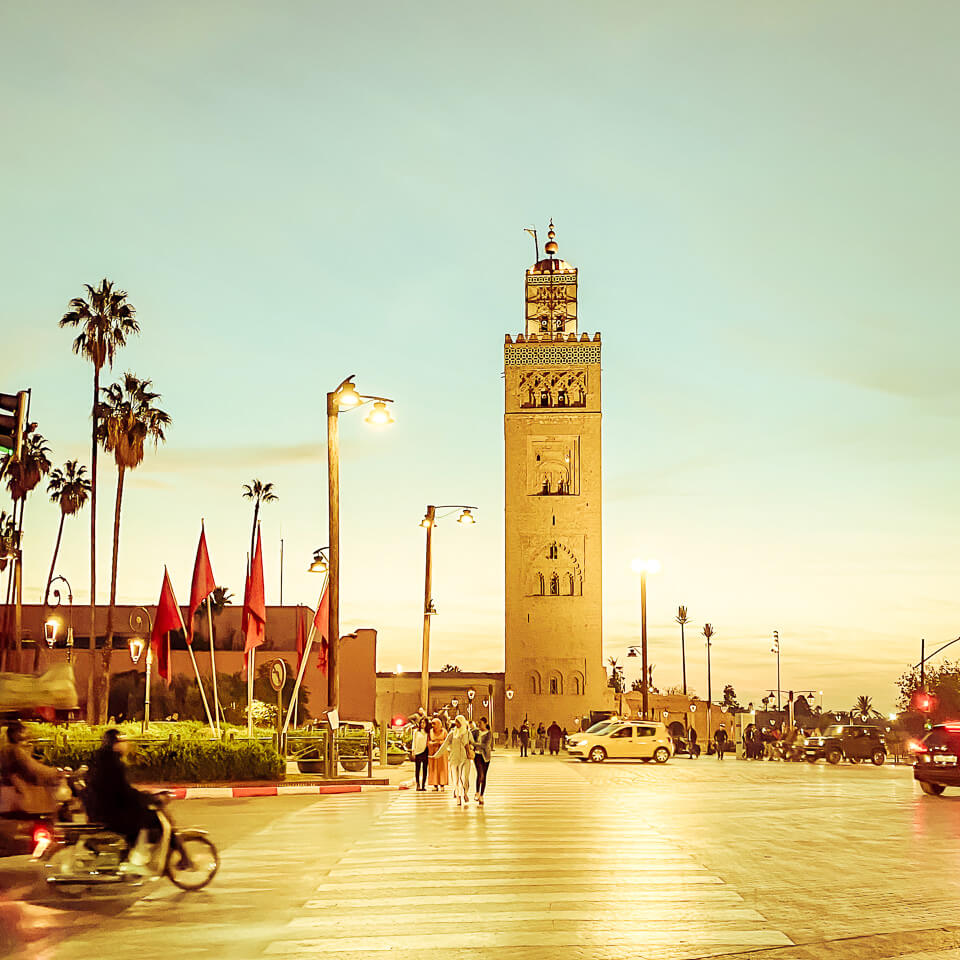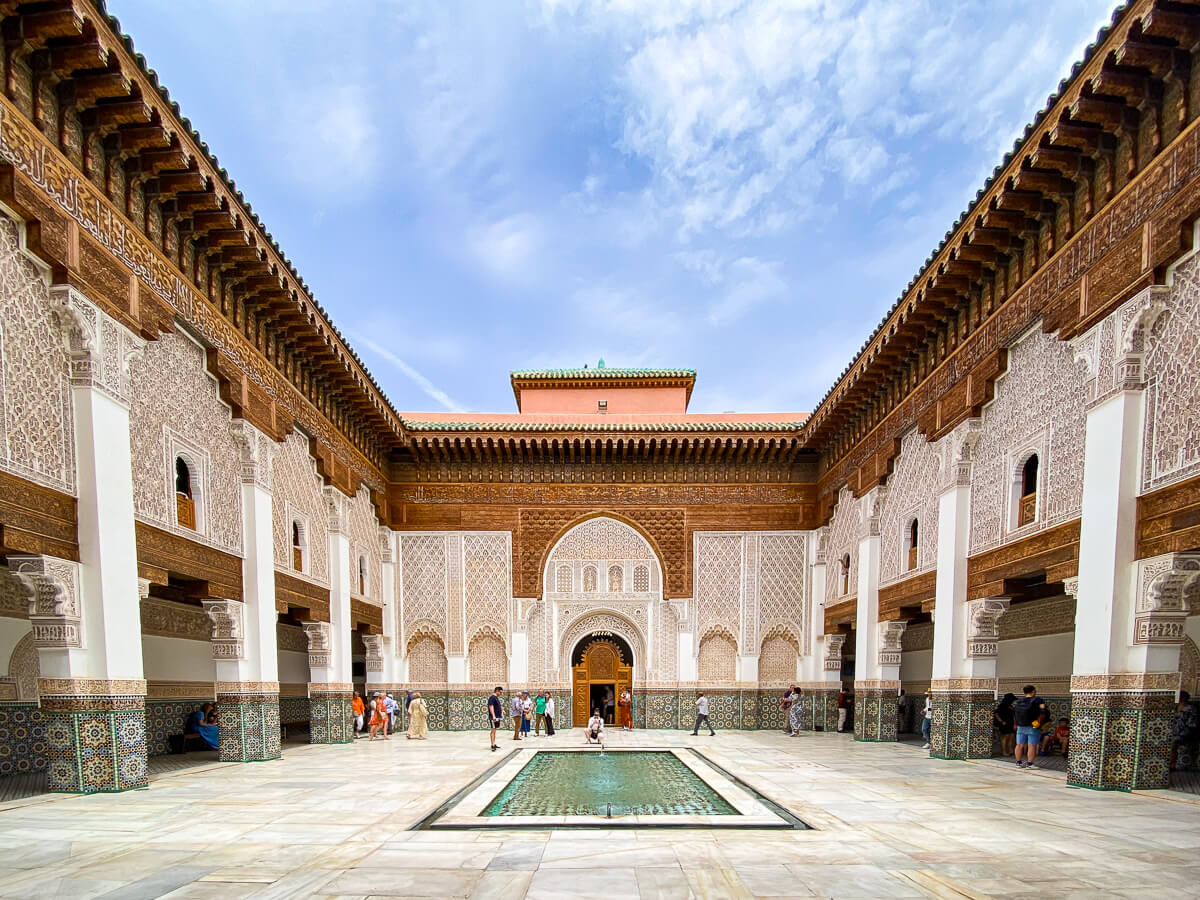The Ben Youssef Koranic school is one of the country’s most important sights from an art-historical perspective. But even those who are not interested in art or history should visit the Madrasa (= koranic school), as the inner courtyard with the water basin and the lavishly decorated building are definitely a feast for the eyes and leave lasting impressions.
Want to save or share this post?
You should plan at least an hour to visit the Madrasa, as it would be a shame to just look at the artistic decorations in passing. If you want to see everything at your leisure, you should be ready in the morning at opening time.
The most striking feature of the Koran school is the spacious inner courtyard with the water basin and the surrounding colonnade, decorated with traditional craftmanship.

If you are unsure whether you should visit the Bahia Palace or the Ben Youssef Madrasa, I would recommend the Madrasa. From an art-historical point of view, the Madrasa is the more beautiful example of Islamic architecture and the visit is also quicker, as the Madrasa is smaller but has the more beautiful overall composition to offer. The Bahia Palace, on the other hand, has a lush garden that rivals the architecture.
Affiliate links: The links marked with an asterisk (*) are referral links, also known as affiliate links. This means that if you buy something via such a link, we receive a small commission. There are no additional costs for you, but with your purchase you help us to continue creating useful content for travelers. Enjoy our stories and “Shukran” for your support!
The Ben Youssef Madrasa can be reached on foot from the Riad Selouane in around 10 minutes.
The entrance is a little hidden in the alleyways. However, the area around the school has also been spruced up in the course of renovation work in recent years. So if you come to an alleyway with chic wood paneling and neat-looking plaster, you’re on the right track.
You can hire a guide at the entrance to the Madrasa. Unfortunately, the Moroccan guides have little to tell you, most of them have memorized the standard phrases and have no in-depth knowledge of the art-historical significance of the Madrasa.
If you would like to know more, you can book a guided city tour*, which also includes a visit to the Madrasa. There are usually more interesting things to learn on these tours than with the local guides.
Due to the translation from Arabic, the Ben Youssef Madrasa is also known as the Ben Youssef Medersa or Madrassa.
History of the Koranic school Ben Youssef Madrasa
The Almoravid dynasty, whose origins lie with the Berbers in the High Atlas, ruled a huge empire in the 12th century that stretched from Spain via Algeria to present-day Senegal. In 1062, the Almoravids founded Marrakech, which they made their capital.
Ali Ben Youssef, the second Almoravid sultan, built the Ben Youssef Mosque, which was completed in 1120. He also had the city wall built, which has surrounded the city unchanged since 1122.
In 1147, the Almohads conquered the city, destroyed it almost completely and rebuilt it as their capital.
In 1269, the Merinid dynasty conquered Marrakech and put an end to Almohad rule.
The Merinids wanted to restore the empire to its former greatness and moved the capital from Marrakech to Fez. To support their rule, they had Koranic schools built throughout the country. However, the Merinids were put under pressure by the Europeans during the reconquest of Spain and eventually lost their territories in Europe.
Sultan Abu al-Hasan, estimated to have been born in 1299, was the 7th Merinid Sultan.
He was also known as the “Black Sultan” due to his dark skin color, as his mother was an Ethiopian slave.
He was known for his artistic sense and began building the koranic school next to the existing Ben Youssef Mosque, which gave the school its name, around 1350.

However, nothing remains of this early building, as the Koranic school was completely rebuilt in the middle of the 16th century.
The Saadian dynasty, which could trace its origins back to the Prophet Muhammad, was less reliant on Koranic schools to underline the legitimacy of its rule. Nevertheless, they built a new Madrasa in Marrakech, which they made their capital, to replace the existing one.
The Saadian Sultan Abdallah al-Ghalib, born in 1517, probably began rebuilding the Madrasa shortly after he came to power. According to an inscription, the work was completed in 1565. The Ben Youssef Madrasa, completed in Merinidian style, was the largest Koranic school in the Maghreb and could accommodate up to 800 students.
The Madrasa was in operation until the 18th century and was finally closed and abandoned.
In the 19th century, it was renovated by the Alaouite Sultan Moulay Hassan I and reopened as an Islamic school. The Madrasa was then in operation until 1960, when it was opened to tourism as a national monument.
In 2017, the Ben Youssef Madrasa was taken over by the Moroccan state and reopened to the public in 2022 after four years of restoration.
Art-historical significance
The Ben Youssef Madrasa is one of Morocco’s most important monuments. The exceptionally well-preserved Koranic school impresses with its rich ornamentation, artistic tile mosaics and ornate carvings.
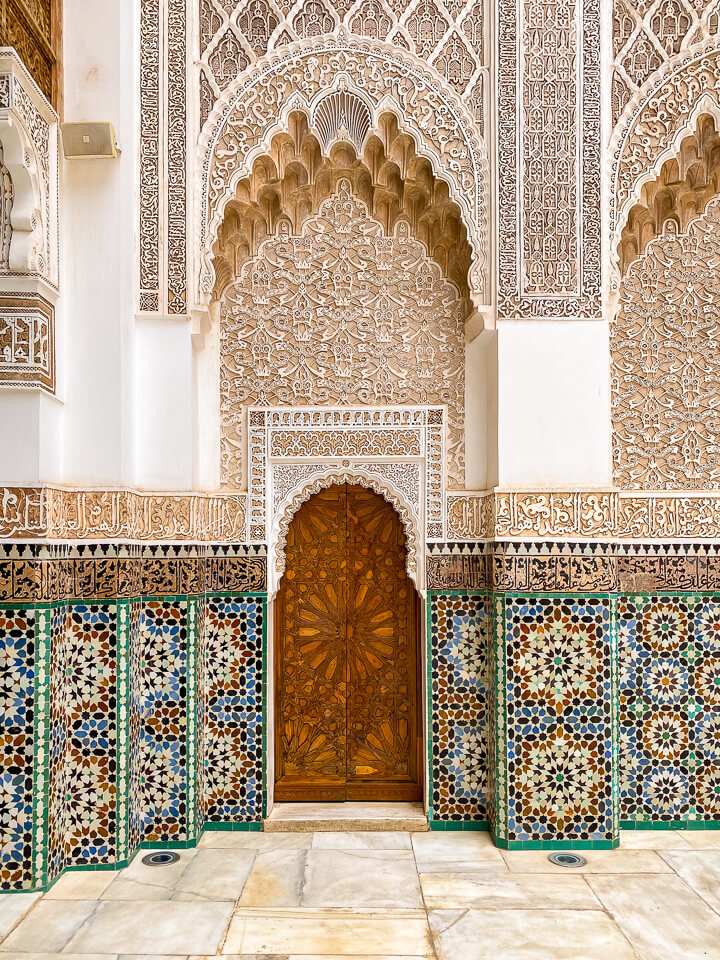
The style is based on the Merinid madrasas, although the school was built during the Saadian period.
Especially in comparison to the Moorish buildings in Spain, the building is largely preserved in its original state and offers a comprehensive overall picture of Islamic architecture.
The filigree work testifies to the incredible dexterity of Moroccan craftsmen.
Architecture
The floor plan of the Madrasa is approx. 40 x 43 m, which results in a floor area of approx. 1700 square meters.
The rooms are grouped around a spacious inner courtyard with a shallow water basin. The bedrooms adjoin on both sides, but do not have direct access to the inner courtyard.
The bedrooms are grouped around a total of 6 inner courtyards, which provide light. The bedrooms vary in size.
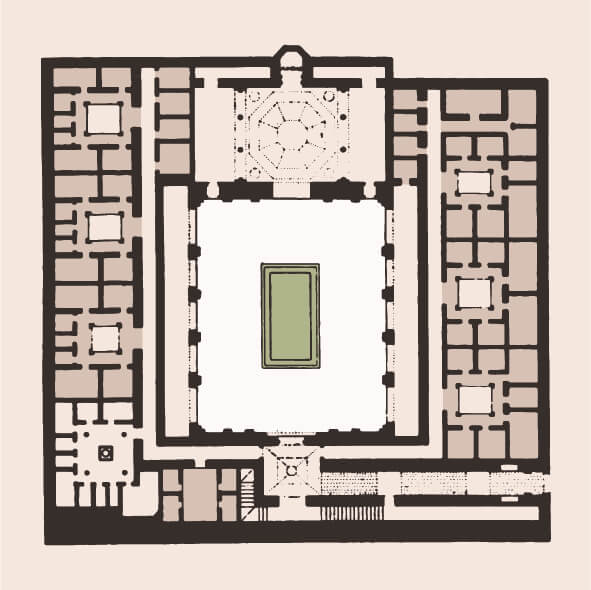
One end consists of the entrance and a staircase, the other end houses the prayer room. The entire complex is arranged symmetrically.
The inner courtyard is richly decorated with tiles, stucco and wood carvings, while the bedrooms are plain and simple. The prayer room is decorated with stucco and marble and has a huge wooden dome.
Entrance
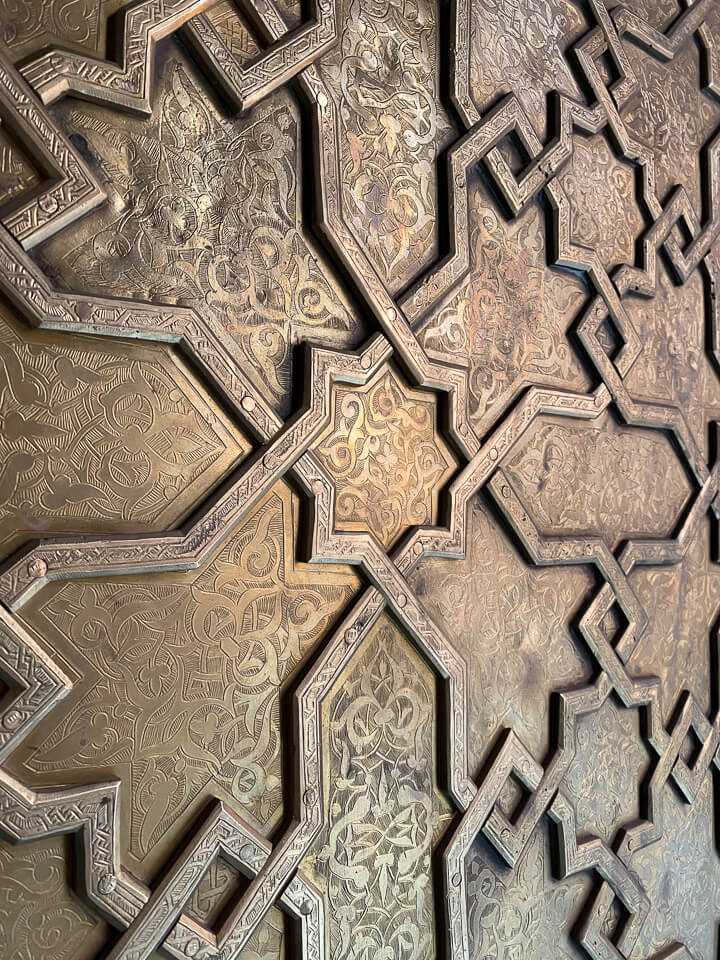
You enter the building through an impressive bronze gate in a quiet alleyway. The gate is gigantic in size. It is all too easy to overlook it when there is a lot going on at the entrance.
The massive gate is decorated with geometric patterns and finely chiseled ornaments.
The inscription above the gate praises Sultan Abdallah as the builder of the Madrasa.
After paying the entrance fee, you walk through a corridor to the central staircase. This long corridor is an important element in Islamic architecture, as it is intended to humble the visitor and then create an aha experience when they reach the actual building.
And it works: The corridor ends in a room with stairs and a large gate into the courtyard — and the sight of the courtyard is truly an aha experience!
The lavishly decorated walls take your breath away at first sight. You truly feel as if you have stepped back in time here. The hustle and bustle of the medina has been left behind and immediately forgotten; even today, the inner courtyard exudes an almost meditative calm.

Two small waterspouts gush into the approx. 3x7 m water basin, which is lined with colorful Moroccan tiles. The inner courtyard is tiled with white marble from the High Atlas.
The walls are covered with tiled mosaics in the lower area, while almost every free surface above is decorated with ornate stucco work. The finishing touch is provided by magnificent wood carvings that extend up to the roof beams.
A portico provides cool shade. The Arabic inscriptions show verses from the Koran.
The prayer hall
On the southern side is the prayer room, which cannot be entered.
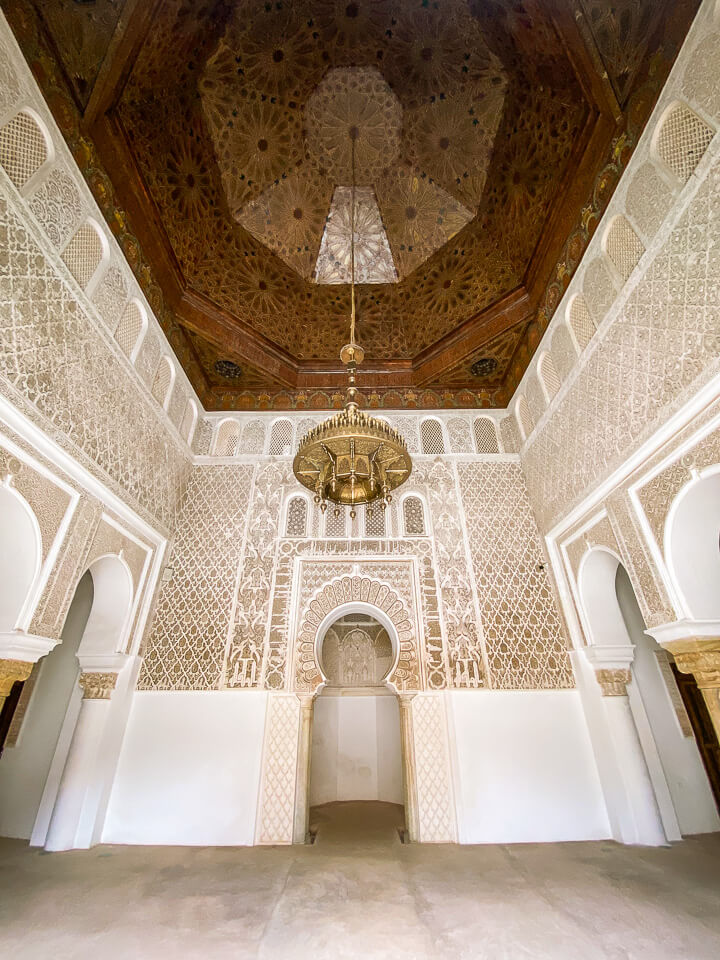
Large pillars divide the room into three parts.
A mighty cedar dome spans the main room, with an impressive bronze chandelier hanging below it.
Under the dome are 24 windows with colorful glass mosaics, which conjure up colorful spots in the prayer hall depending on the position of the sun.
In the middle of the room is an ornate marble basin that was used as a washbasin. Made in Cordoba around the year 1000, it came to Morocco after the loss of the Spanish territories in the 13th century and has been used in the Ben Youssef Madrasa ever since.
After the end of teaching activities, it stood for many years in the Dar Si Said Museum and was only returned to the Koran school during the last renovation work.
The niche behind the basin, called the mihrab, indicates the direction of prayer.
It is decorated with particularly beautiful stucco.
Koranic suras adorn the wall above the niche.
The marble of the white columns comes from Italy. Carrara marble was already world-famous at that time and was sold all over the world.
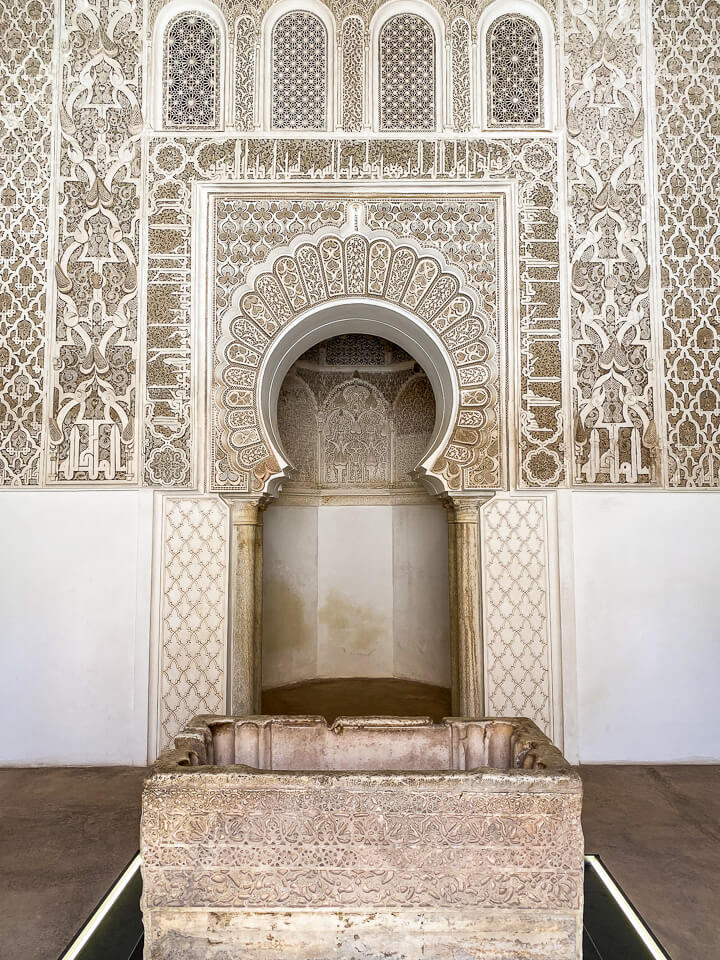
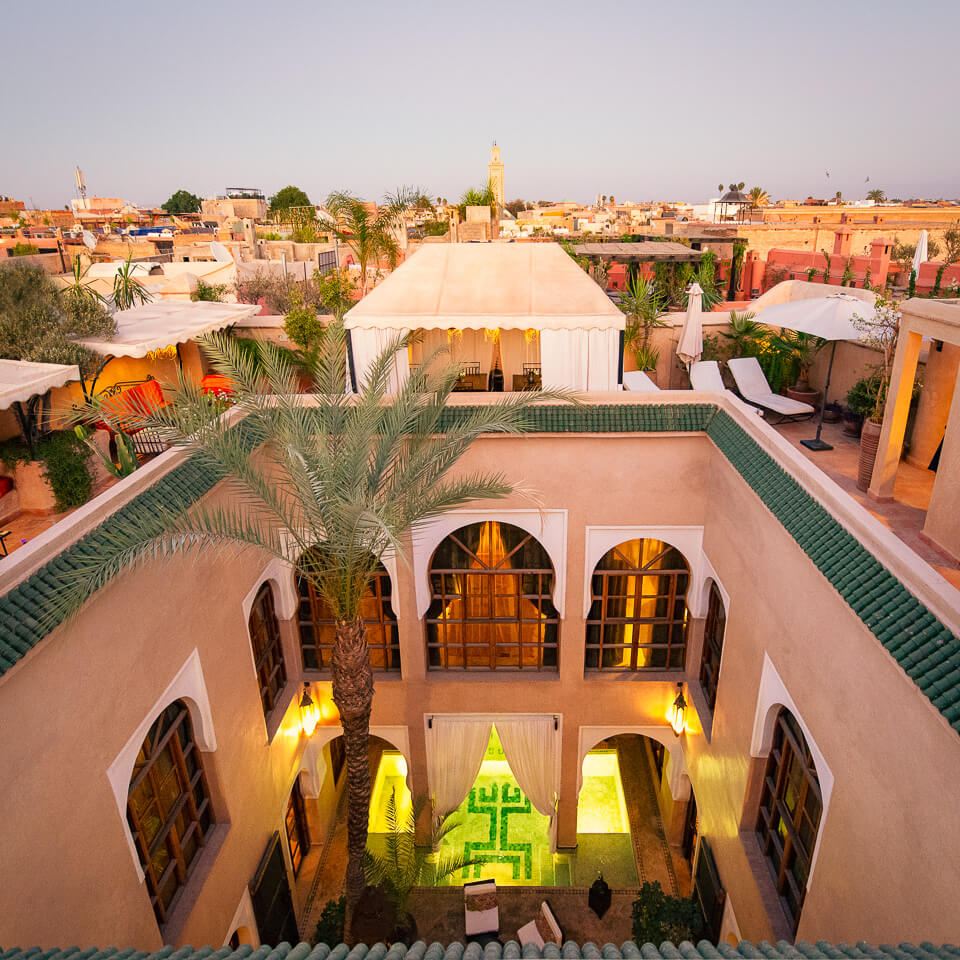
Craftmanship
The entire building is far too lavishly decorated to take in everything at a glance. Take your time and admire the artistic mosaics, stucco reliefs and carvings. It is not often that you get to see such a masterpiece of Moorish architecture!
What artists the craftsmen of the time must have been to carve the tiles, model the plaster or decorate the beams with such precision and finesse. And all this without modern tools!
After all, you have to bear in mind that most of the decorations on display here are almost 500 years old!
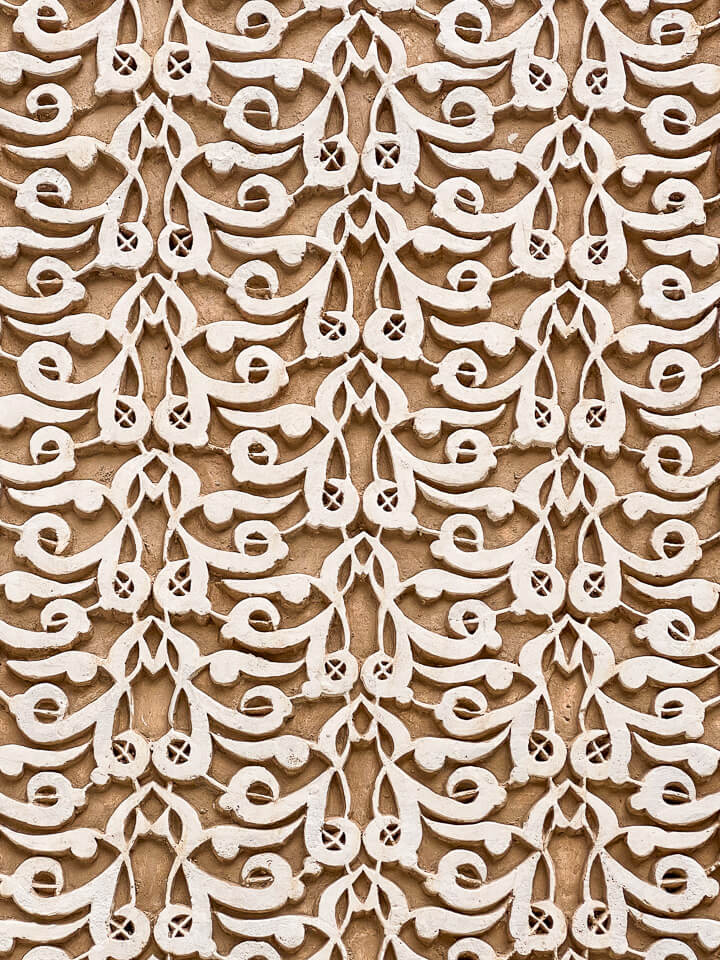


The finely crafted stucco reliefs are carved into the damp plaster with small knives. If you look closely, you can see the border of the so-called day’s work — this is the area that the artist completed one day before applying new plaster the next day.
The stucco has a slightly pink color, as it comes from the Asni area near Marrakech. Marble powder was mixed in to make it whiter.

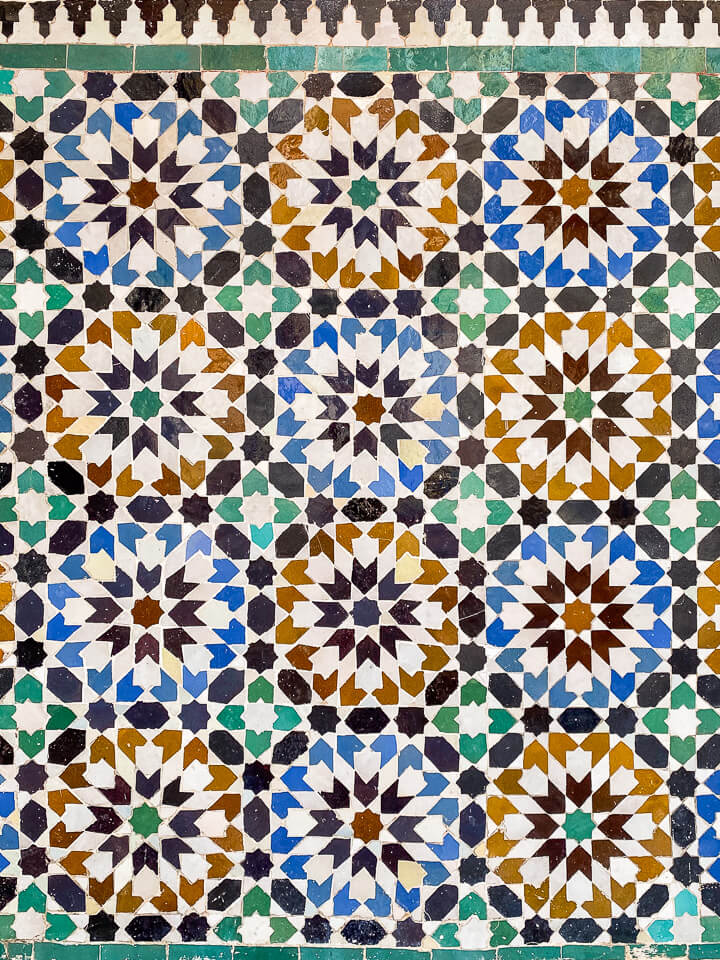
Even today, Moroccan craftsmen are still masters of their trade and I am always amazed at the dexterity with which traditional working methods are still used today.
The glazed tiles are called Zellige and are hewn into the right shape by hand with a small hammer. The patterns are traditional and are still produced in exactly the same way today. The craftsmen know exactly what shape the tiles must have in order to reproduce even the most complicated patterns afterwards and it is incredible how precisely they can carve the tiles.


The ceilings and ceiling beams are decorated with a mixture of relief and painting. Although they are many meters high, there is no lack of detail. You almost wish you had binoculars to see everything in detail!

The wood used for the carvings and roof beams comes from the cedars of the Middle Atlas.
If you look up in the courtyard, you can discover beautiful Islamic vaults in the corners of the courtyard.
These muqarnas, or honeycomb vaults, are typical of Islamic architecture and are complicated to make.
The students’ accommodation
The rooms for the students are located in the side wings, both on the first floor and the upper floor. Long corridors lead to small atriums around which small, sparse cells are arranged.


There are 130 of these cells in total. Some of the cells are two-storey, some have windows and all were apparently occupied by several students.

The cells are functional, small and offer little space for furniture. There can’t have been much more than a place to sleep in the cells.
Some of the cells offer a beautiful view of the inner courtyard.
Some of the more spacious cells were apparently reserved for teachers.
The washroom
On the first floor of the eastern wing is the old bathing facility, now appropriately used as a toilet.
Even if you don’t need to use the restroom, you should take a look inside.
4 beautiful columns surround a water basin in the middle and it is easy to imagine how students used to wash themselves here.

The theological school
The Madrasa is not the actual school, but only the dormitory of the Koran school. Students who did not come from Marrakech could stay here to be taught in the nearby Ben Youssef Mosque.
The mosques were the actual places of learning and the sultan’s palaces were also used for teaching.

Islamic theology and Islamic law were taught. It is said that over 800 students studied here.
A student of the Koranic school was called a taleb. Literally the seeker, this term referred to a student of religious studies.
The Madrasa mainly took in boys from the areas of the High Atlas and the regions south of it. Most of them had already memorized the Koran from the age of 7. They also learned Arabic, as the people in the mountain regions are Berber and therefore speak Berber rather than Arabic.
Basic education in their villages was completed by the age of 10. Those who wanted to study further were taught in special schools in the larger towns. The education included grammar, literature, the basics of law and Islamic religious studies.
Fancy a city tour of Marrakech?
Our partner GetYourGuide* offers guided city tours and food tours with friendly local guides who will show you the hidden corners of the medina.
Only at the age of 20 could the best students transfer to a prestigious Koranic school such as the Ben Youssef Madrasa and continue their studies with a degree. This required a recommendation from their teacher and they had to pass an entrance test.
The cost of the education was borne by the sultan. They cooked, ate and slept in the rooms.
Lessons took place in the mosque next door. Some courses also took place in the Madrasa. Students could also attend classes in the other mosques in the city. Some of the teachers were very famous and students came from far to attend their classes.
In the first centuries of the Koran school, religion was the main subject taught. Later, the Arabic language and subjects such as philosophy, medicine, mathematics, astronomy, geography, physics and chemistry were added.
Some students improved their financial situation by copying old texts or textbooks. The libraries were located at the mosques, not in the Madrasa.
Education relied heavily on memorization and listening rather than practicing.
The education was completed by a pilgrimage to the holy cities in the countries of the Middle East.

Even today, the Madrasa exudes an air of calm that makes it easy to imagine students sitting in the shade of the pillars, reviewing their lessons or chatting with their friends.
In any case, I find it fascinating how much importance was attached to a pleasant spatial atmosphere in earlier times, which supported the reason for the building’s existence so well and has survived over the centuries.
The Ben Youssef Madrasa is a real oriental gem.
Ben Youssef Madrasa
Rue Assouel
Marrakech 40000, Maroc
www.medersabenyoussef.ma
The Madrasa is open daily from 09 — 19 hrs. The entrance fee is 50 dirhams.
